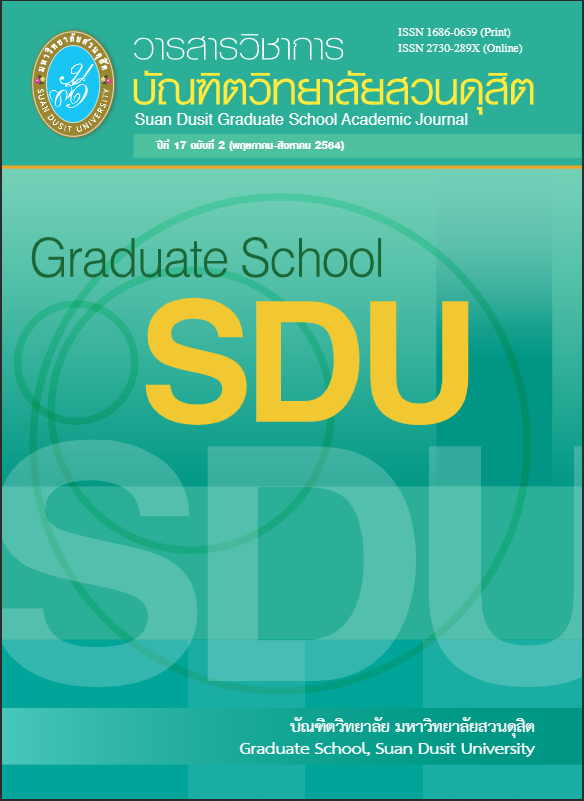The Effects of Online Learning Management Towards English Grammar Achievement of Business English Students
Keywords:
Online Learning, Online Grammar Exercises, English Grammar KnowledgeAbstract
This research study aimed to compare Business English students' achievement in English grammar before and after obtaining online learning management, and to explore their perceptions towards the development of English grammar knowledge. Quantitative and qualitative research were used. The subjects were 43 Business English senior students in Academic Year 2017 who did the tests and responded to the questionnaires and 5 students were purposively selected to have a group interview. Research instruments were the pretest-posttest, questionnaire and interview schedule. The content validity index of every question in the questionnaire was 1.00. Quantitative data were analyzed by frequency distribution, percentage, mean, standard deviation and dependent sample t-test. Major findings revealed that Business English students' achievement in English grammar improved after online self-study at the statistical significance level of .05. The students showed an agreement with the development of English grammar knowledge through online self-study. The first aspect showing a strong agreement indicated that students learned the content from online grammar exercises as much as they could. Findings from the interview revealed three aspects: being convenient for online self-study through Application, development of grammatical competence and an ability to apply their knowledge to take the TOEIC test.
References
กันตพร สวนศิลป์พงศ์, กนกพรรณ อรรัตนสกุล, ปริชมน จันทร์ศิริ, ภัทรมน สุขประเสริฐ, และ ศิวะภาคเจียรวนาลี. (2557). เจาะลึก Line แอพพลิเคชันที่มัดใจคนทั่วโลก. a day, 14 (165), 89-146.
ณภัทร วุฒิวงศา. (2557). กลยุทธ์สร้างแรงจูงใจ: การพัฒนาทักษะภาษาอังกฤษ Motivational strategies: Enchancing English language skils. วารสารนักบริหาร Executive Journal, 34 (1), 89-97.
มหาวิทยาลัยสวนดุสิต. (2561). แผนกลยุทธ์มหาวิทยาลัยสวนดุสิต 2561-2564 (ฉบับสมบูรณ์). กรุงเทพฯ: สวนดุสิตกราฟฟิกไซต์.
วิจารณ์ พานิช. (2555). วิถีสร้างการเรียนรู้เพื่อศิษย์ในศตวรรษที่ 21. [Online]. Available: http://www.noppawan.sskru.ac.th/data/learn_C21.pdf [2559, มิถุนายน 18].
สุพรรณี อาศัยราช และ นันทวดี วงษ์เสถียร. (2557). การพัฒนาบทเรียนไวยากรณ์ภาษาอังกฤษแบบเน้นภาระงานโดยใช้เอกสารจริงด้านสังคมและวัฒนธรรมของเจ้าของภาษา. พระนครศรีอยุธยา: มหาวิทยาลัยเทคโนโลยีราชมงคลสุวรรณภูมิ.
สำนักงานคณะกรรมการพัฒนาการเศรษฐกิจและสังคมแห่งชาติ. (2558). ทิศทางของแผนพัฒนาเศรษฐกิจและสังคมแห่งชาติ ฉบับที่ 12 พ.ศ. 2560-2564. [Online]. Available: http://www.nesdb.go.th/article_attach/Book_Plan12,pdf [2559, มิถุนายน 18].
Batstone, R. (1994). Grammar. Oxford: Oxford University Press.
Boldt, R.F. & Ross, S.J. (1998). Scores on the TOEIC (Test of English for International Communication) Test as a Function of Training Time and Type. [Online]. Available: https://www.ets.org/Media/Research/pdf/TOEIC-RR-03.pdf [2017, January 28].
Canale, M. & Swain, M. (1980). "Theoretical Bases of Communicative Approaches to Second Language Teaching and Testing." Applied linguistics, 1, 1-47.
Chen, T. (2014). Voices of four Taiwanese College Students' Experiences With the Test of English for International Communication (TOEIC) Preparation (PREP) Computer Assisted Language Learning (CALL). Doctoral Dissertation, Texas A & M University. [Online]. Available: http://hdl.handle.net/1969.1/152524 [2017, January 28].
Derewianka, B. (2008). A Grammar Companion for Primary Teachers. Sydney: PETA.
Dickin, P.M. (1991). What Makes a Grammar Test Communicative?. London: McMillan Publisher Ltd.
Dickins, P.M. & Woods, E.G. (1988). Some Criteria for the Development of Communicative Grammar Tasks. TESOL Quarterly, 22 (4), 623-646.
Educational Testing Service. (2016). 2015 Report on Test Takers Worldwide: The TOEIC® Listening and Reading Test. [Online. Available: https://www.ets.org/s/toeic/pdf/ww_data.report_unlweb.pdf [2017, January 29].
Gardner, R.C. (1985). Social Psychology and Second Language Learning: The Roles of Attitudes and Motivation. London: Edward Arnold.
Google. (2017). Google forms. [Online]. Available: https://www.google.com/intVen/forms/about/ [2017, January 28].
Harmer, J. (2007). The Practice of English Language Teaching. Essex: Pearson Education.
Learning Course Design: Utilizing Students' Mobile Online Devices. In F. Helm, L. Bradley, M. Guarda, & S. Thouësny (Eds), Critical CALL - Proceedings of the 2015 EUROCALL Conference, Padova, Italy (pp. 261-267). [Online]. Available: http://dx.doi.org/10.14705/rpnet.2015.000343 [2017, February 10].
Leech, G.N. (1983). Principle of pragmatics. Essex: Longman.
Lightbrown, P. (1985). Can Language Acquisition be Altered by Instruction? In Hyltenstam and Pienemann (eds.) Modeling and Assessing Second Language Acquisition. Clevedon, North Somerset: Multilingual Matters.
Lougheed, L. (2017). Barron's TOEIC Practice Exams. Hauppauge, New York: Barron's Educational Series.
Lougheed, L. (2007). Longman Preparation Series for the New TOEIC Test: Intermediate Course. White Plains, New York: Pearson Education.
Lougheed, L. (2006). Longman Preparation Series for the New TOEIC Test: Introductory Course. White Plains, New York: Pearson Education.
Mccarthy, F. (2000). Lexical and Grammatical Knowledge in Reading and Listening Comprehension by Foreign Language Learners of Spanish. Applied Language Learning, 11, 323-348.
Masgoret, A.M. & Gardner, R.C. (2003). Attitudes, Motivation, and Second Language Learning: A Meta-analysis of Studies Conducted by Gardner and Associates. Language Learning, 53 (1),123-163.
Nunan, D. (2004). Task-based Language Teaching. Cambridge: Cambridge University Press.
Skinner, B.F. (1971). Beyond Freedom and Dignity. Harmondsworth, Middlesex: Penguin Books.
Strauss, A. & Corbin, J. (2015). Basics of Qualitative Research: Techniques and Procedures for Developing Grounded Theory. Thousand Oaks, California: Sage.
Tamimi, A.A. & Shuib, M. (2009). Motivation and Aattitudes Towards Learning English: A Study of Petroleum Engineering Undergraduates at Hadhramout University of Sciences and Technology. GEMA Online Journal of Language Studies, 9 (2), 29-55.
Van Han, N. & van Rensburg, H. (2014). The Effect of Computer Assisted Language Learning (CALL) on Performance in the Test of English for International Communication (TOEIC) Listening Module. English Language Teaching, 7 (2), 30.
Winserr, B. & Cheung, W. (1996). The Quality of Software for Computer-based Literacy Learning. RELC Journal, 27 (2), 83-99.
Wu, Q. (2015). Designing a smartphone App to Teach English (L2) Vocabulary. Computers & Education, 85 (July), 170-179.
Downloads
Published
How to Cite
Issue
Section
License
Copyright (c) 2021 Suan Dusit Graduate School Acadamic Journal

This work is licensed under a Creative Commons Attribution-NonCommercial-NoDerivatives 4.0 International License.






